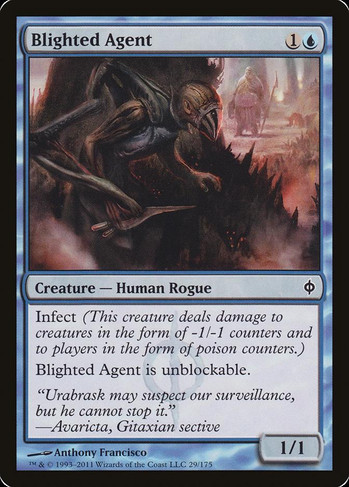Deck of the Week: Modern Infect
- Connor Kirkwood
- Feb 8, 2023
- 6 min read
What is Infect?
With Phyrexia: All Will Be One coming out this weekend, it’s only proper that we discuss one of the scariest boogeymen in Modern Magic's history, Infect. As you can guess, Infect came about in Modern when the keyword, Infect, was introduced in the Scars of Mirrodin block. With new cards like Glistener Elf, Blighted Agent, and Inkmoth Nexus, players could now win the game as early as turn two by giving the opponent poison counters.
Poison counters are an alternate way to kill your opponents in Magic; once your opponent has ten poison counters, they lose the game. While poison counters have been around since Legends in 1994, Infect has only been around for about 13 years. The original poison creature, Pit Scorpion, gave your opponent a poison counter whenever it dealt damage to them. Infect updated this ability by replacing the damage the creature would do with poison counters. So, if a creature with Infect would deal 10 damage to your opponent, instead, your opponent would get 10 poison counters.
This update brought about Modern Infect, which had a game plan of playing an Infect creature on turn one or two and casting pump spells on it on turn two or three, giving your opponent 10 poison counters and ending the game. The speed and resilience of the deck made it a dangerous addition to the Modern meta, and although the deck has fallen out of the first tier, Phyrexia: All Will Be One may be what it needs to return to the spotlight.
How has infect changed since 2010?
Since Infect is a fringe deck in this day and age, many newer players have never felt the fear instilled from a turn-one Glistener Elf. However, the deck has changed a lot since its inception, and new creatures have been added. With the addition of Ignoble Hierarch from Modern Horizons 2, Infect cut the four Noble Hierarchs out of the deck. This is very important, since Ignoble Hierarch can tap for black mana while still providing your Infect creatures with Exalted. Ignoble Hierarch allows Infect to play a couple of extra threats like Plague Stingers and Phyrexian Crusaders.
Why is this so important? Infect used to be solely green and blue, relying on Blighted Agent and spells like Dispel and Slip Through Space to help get the damage through. While some Infect decks still retain the blue, many Infect players have switched to playing black for multiple reasons. Black allows them to play Thoughtseize, which can be essential to protecting your plan and disrupting your opponent’s plan.
It also allows players to easily switch from Blighted Agent to Plague Stingers. While this is not an exact one-for-one trade, they are both 1/1 Infect creatures with evasion, which is what the deck needs. Blighted Agent’s evasion may be slightly better than Plague Stinger’s, but Plague Stinger can block creatures in the air. Infect players are not usually supposed to be blocking; however, if your Hammertime opponent activates their Inkmoth Nexus and swings with it, you will be very happy to block it with your Plague Stingers before they attach a massive hammer to it.
The third and arguably most important addition to the deck is Phyrexian Crusader. Modern is dominated by red and white decks these days, and this deck will happily use a card that evades Lightning Bolt, Unholy Heat, Fury, Leyline Binding, Prismatic Ending, and Solitude. Ignoble Hierarch allows you to get Phyrexian Crusader down on turn two, and this creature can easily end the game on turn three.
how does this deck win?
So you’ve heard all about the creatures in the deck, but how do they actually kill your opponent? The deck plays a plethora of pump spells, and with a perfect hand, you can quickly kill your opponent on turn two with poison counters. Since the beginning, Infect has run cards like Might of Old Krosa and Vines of Vastwood, which both can give your creature +4/+4, and Vines can even protect it from removal spells.
Infect also runs a playset of Mutagenic Growth, and even though it only gives +2/+2, its ability to be played at instant speed for free, thanks to its Phyrexian mana symbol, makes it a very dangerous card. This allows you to play multiple copies on your creature on turn two or trick your opponent into thinking you can’t pump it more and possibly bait them into wasting a burn spell on it.
In recent years, Infect has picked up a couple of spells that have added to its deadliness. In 2016 the deck received Blossoming Defense from Kaladesh, which not only protected its creatures at instant speed but also buffed them. Three years later, the deck received one of its most powerful additions with Scale Up from Modern Horizons. This gave Infect the most powerful pump spell in its arsenal, giving Infect creatures six power for only one mana. Now it is even easier to win on turn two since you could play a Glisterner Elf on turn one and then pump it with a Scale Up followed by a Might of Old Krosa or Mutagenic Growths for lethal.
So if Infect is not a tier-one deck, why talk about it now? As I said before, many people don’t understand just how much danger they are in when their opponent is on the play and plays a turn-one Glistener Elf. Most of the time, you must kill the elf immediately, or you will soon be heading to game two. In the hands of a well-versed player, Infect can be a devastating deck. And, with the addition of the keyword Toxic from Phyrexia: All Will Be One, a new way for opponents to gain poison counters has emerged.
phyrexia: All will be one
Phyrexia: All Will Be One provided Infect with two new cards that pushed it even closer to becoming a tiered deck once again. The first card is Tyvar’s Stand, a card similar to Blossoming Defense, but it scales as the game goes on and provides indestructible as well. This is important as it now can protect creatures against board wipes, which the deck did not have a good answer to before.
The second addition to the deck is Venerated Rotpriest, a new ‘Toxic’ rare from Phyrexia. The Rotpriest provides the deck with a way of pushing poison counters onto your opponent without needing to attack. Infect used to have a real problem when its opponent had Ensnaring Bridge in play, but not anymore! Now if your opponent stalls the board or prevents you from attacking, you can simply keep targeting your creatures with spells and eventually your opponent will die!
Even if your opponent plays a Chalice of the Void on one, you can still cast your spells on your creatures to give your opponents poison counters. It will also make your opponents think twice about using their removal spells on your creatures, as each removal spell they use gives them another poison counter. And, of course, don’t forget that the Rotpriest essentially adds +1 to all your pump spells since it will give your opponents another poison counter for each pump spell played. The only downside to Rotpriest is that it has Toxic instead of Infect, so if you play this on turn one and play a million pump spells on it on turn two, it will still only give one poison counter.
The future of infect
While Infect is a very powerful deck in the right hands, I don’t believe it will become a tier-one deck in the near future. I think it has a possibility to push into tier two, but the interesting thing about Infect is that it usually isn’t a deck that people just pick up and play. Of all the Infect players I have met, they all LOVE infect, and it seems to become a part of their identity. Due to this fact, I don’t see Infect becoming a mainstay in the Modern Meta, but I do think that it means that if your opponent plays a turn-one Glistener Elf, you might be in a lot of trouble.
Will Infect have a resurgence in Legacy, or will Toxic become a deck in Pioneer? That remains to be seen, but this is not a deck to sleep on. I believe it is possible to see this win a major tournament, and all it will take is an intelligent and well-versed player with a little bit of luck to pick up the deck and carry it to the finals.
The deck below was taken to the top four of a Modern tournament by Nishio Yusuke, and the decklist can be found here.






























Comments